Analys
A ”Game of Chicken”: How long do you dare to wait before buying?

The EUA market rallied 3.4% ydy and is adding another 0.5% this afternoon with EUA Dec-24 at EUR 54.2/ton. Despite the current bounce in prices we think that the ongoing sell-off in EUA prices still has another EUR 10/ton downside from here which will place the low-point of EUA Dec-24 and Dec-25 at around around EUR 45/ton. Rapidly rising natural gas inventory surplus versus normal and nat gas demand in Europe at 23% below normal will likely continue to depress nat gas prices in Europe and along with that EUA prices. The EUA price will likely struggle to break below the EUR 50/ton level, but we think it will break.

That said, our strong view is still that the deal of the year is to build strategic long positions in EUA contracts. These certificates are ”licence to operate” for all companies who are participants in the EU ETS irrespective whether it is industry, shipping, aviation or utilities. We have argued this strongly towards our corporate clients. The feedback we are getting is that many of them indeed are planning to do just that with board approvals pending. Issuance of EUAs is set to fall sharply from 2026 onward. The Market Stability Reserve (MSR) mechanism will clean out any surplus EUAs above 833 m t by 2025/26. Medium-term market outlook 2026/27 is unchanged and not impacted by current bearish market fundamentals with fair EUA price north of EUR 100/ton by then. Building strategic long position in EUAs in 2024 is not about pinpointing the low point which we think will be around EUR 45/ton, but instead all about implementing a solid strategic purchasing plan for EUAs for 2024.
The ingredients in the bottoming process will be: 1) Re-start of European industry as energy prices come down to normal, 2) Revival in nat gas demand as this happens, 3) Nat gas prices finding a floor and possibly rebounding a bit as this happens, 4) Asian nat gas demand reviving as nat gas now normally priced versus oil, 5) Strategic purchasing of EUA by market participants in the EU ETS, 6) Speculative buying of EUAs, 7) Bullish political intervention in H2-24 and 2025 as EU economies revive on cheap energy and politicians have 2024-elections behind them.
On #1 we now see calculations that aluminium smelters in Europe now are in-the-money but not restarted yet. On #2 we see that demand destruction (temp. adj.) in Europe is starting to fade a bit. On #3 we have not seen that yet. On #4 we see stronger flows of LNG to Asia. On #5 we see lots of our corporate clients planning to purchase strategically and finding current EUA prices attractive. On #6 it may be a bit early and so as well for #7.
For EU ETS participants it may be a ”Game of Chicken”: How long do you dare to wait before buying? Those who wait too long may find the carbon constrained future hard to handle.
Ydy’s short-covering rally lost some steam this morning before regaining some legs in the afternoon. The EUA Dec-24 ydy rallied 3.4% to EUR 53.97/ton in what looks like a short-covering-rally in both coal, nat gas, power and EUAs. This morning it gave almost all of the gains back again before regaining some strength in the afternoon to the point where it is now up at EUR 54.7/ton which is +1.4% vs. ydy. A weather forecast promising more seasonally normal temperatures and below normal winds could be part of the explanation.
The power market is currently the main driver and nat gas prices the most active agent. The main driver in the EUA market is the power market. When the EUA market is medium-tigh (not too loose and not too tight), then the EUA price will naturally converge towards the balancing point where the cost of coal fired electricity equals the cost of gas fired electricity. I.e. the EUA price which solves the equation: a*Coal_price + b*EUA_price = c*Gas_price + d*EUA_price where a, b, c and d are coefficients given by energy efficiency levels, emission factors and EURUSD fex forward rates. As highlighted earlier, this is not one unique EUA balancing price but a range of crosses between different efficiencies for coal power and gas power versus each other.
Coal-to-gas dynamics will eventually fade as price driver for EUAs but right now they are fully active. Eventually these dynamics will come to a halt as a price driver for the EUA price and that is when the carbon market (EU ETS) becomes so tight that all the dynamical flexibility to flex out of coal and into gas has been exhausted. At that point in time the marginal abatement cost setting the price of an EUA will move to other parts of the economy where the carbon abatement cost typically is EUR 100/ton or higher. We expect this to happen in 2026/27.
But for now it is all about the power market and the converging point where the EUA price is balancing the cost of Coal + CO2 equal to Gas + CO2 as described above. And here again it is mostly about the price of natural gas which has moved most dramatically of the pair Coal vs Gas.
Nat gas demand in Europe is running 23% below normal and inventories are way above normal. And natural gas prices have fallen lower and lower as proper demand recovery keeps lagging the price declines. Yes, demand will eventually revive due low nat gas prices, and we can see emerging signs of that happening both in Europe and in Asia, but nat gas in Europe is still very, very weak vs. normal. But reviving demand is typically lagging in time vs price declines. Nat gas in Europe over the 15 days to 25. Feb was roughly 23% below normal this time of year in a combination of warm weather and still depressed demand. Inventories are falling much slower than normal as a result and now stand at 63.9% vs. a normal 44.4% which is 262 TWh more than normal inventories.
Bearish pressure in nat gas prices looks set to continue in the short term. Natural gas prices will naturally be under pressure to move yet lower as long as European nat gas demand revival is lagging and surplus inventory of nat gas keeps rising rapidly. And falling front-end nat gas prices typically have a guiding effect on forward nat gas prices as well.
Yet lower nat gas prices and yet lower EUA prices in the near term most likely. Nat gas prices in Europe will move yet lower regarding both spot and forwards and the effect on EUA will be continued bearish pressure on prices.
EUA’s may struggle a bit to break below the EUR 50/ton line but most likely they will. EUA prices will typically struggle a bit to cross below EUR 50/ton just because it is a significant number. But it is difficult to see that this price level won’t be broken properly as the bearish pressure continues from the nat gas side of the equation. Even if nat gas prices comes to a halt at current prices we should still see the EUA price break below the EUR 50/ton level and down towards EUR 45/ton for Dec-24 and Dec-25.
The front-year nat gas price is the most important but EUA price should move yet lower even if it TTF-2025 stays unchanged at EUR 27.7/ton. The front-year is the most important for the EUA price as that is where there is most turnover and hedging. The following attractors for the EUA forward prices is with today’s TTF forward price curve (TTF Cal-2025 = EUR 27.7/ton) and today’s forward EURUSD FX curve and with ydy’s ARA coal closing prices. What it shows is that the forward EUA attractors are down at EUR 45/ton and lower.
The front-year Coal-to-Gas differential is the most important ”attractor” for the EUA price (Cal-2025 = average of Dec-24 and Dec-25) and that is down to around EUR 45/ton with a TTF Cal-2025 price of EUR 27.7/ton. The bearish pressure on EUA prices will continue as long as the forward nat gas prices are at these price levels or lower.

And if we take the EUA attractors from all the different energy efficiency crosses between coal and gas then we get an average attractor of EUR 44.2/ton for EUA Cal-2025 (= average of Dec-24 and Dec-25) versus a market price today of EUR 53.9/ton.
Calculating all the energy efficiency crosses between coal and gas power plants with current prices for coal and nat gas for 2025 we get an average of EUR 44.2/ton vs an EUA market price of EUR 53.9/ton. Bearish pressure on EUAs will continue as long as this is the case.
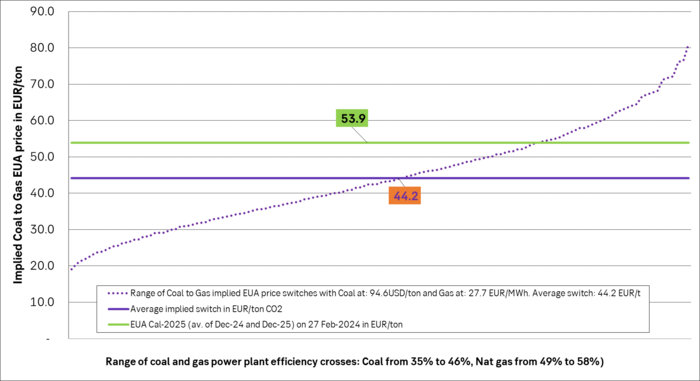
Utility hedging incentive index still deeply negative: Utilities have no incentive currently to buy coal, gas and EUAs forward and sell power forward against it as these forward margins are currently negative => very weak purchasing of EUAs from utilities for the time being.
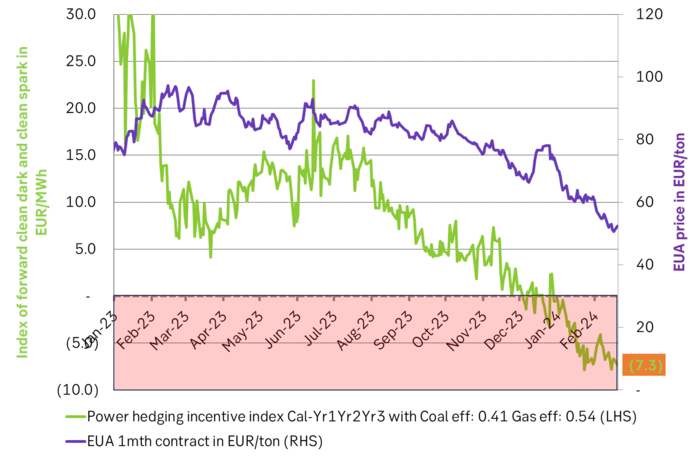
Natural gas in Europe for different periods with diff between actual and normal decomposed into ”price effect” and ”weather effect”. Demand last 15 days were 23% below normal!
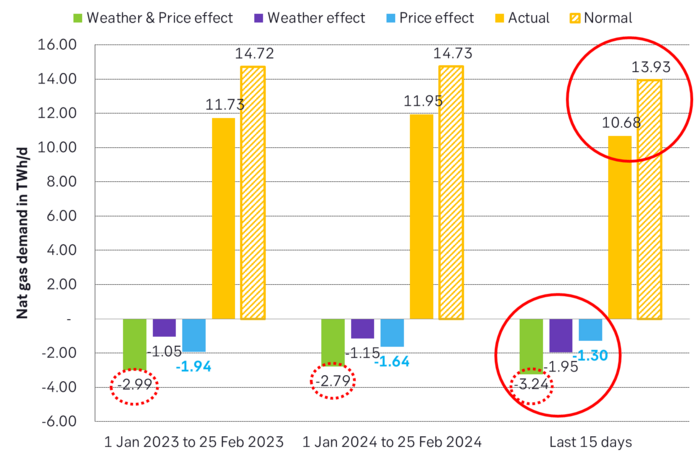
Natural gas inventories in Europe vs the 2014-2023 average. Surplus vs. normal is rising rapidly.
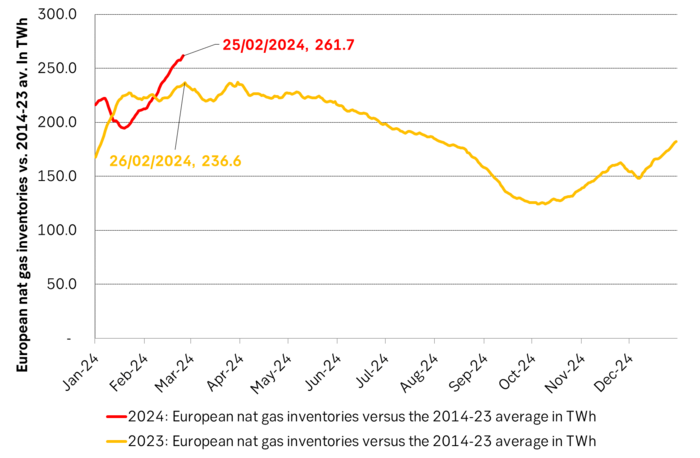
Nat gas inventories in Europe at record high for the time of year. Depressing spot prices more and more. Nat gas prices are basically shouting: ”Demand, demand, where are you?? Come and eat me!”
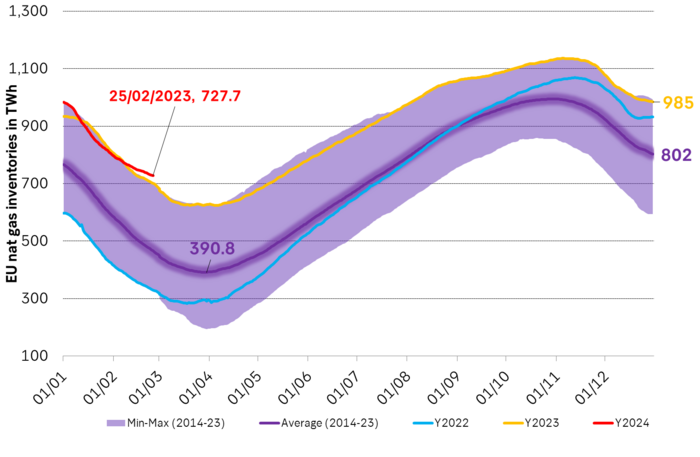
Analys
Tightening fundamentals – bullish inventories from DOE

The latest weekly report from the US DOE showed a substantial drawdown across key petroleum categories, adding more upside potential to the fundamental picture.

Commercial crude inventories (excl. SPR) fell by 5.8 million barrels, bringing total inventories down to 415.1 million barrels. Now sitting 11% below the five-year seasonal norm and placed in the lowest 2015-2022 range (see picture below).
Product inventories also tightened further last week. Gasoline inventories declined by 2.1 million barrels, with reductions seen in both finished gasoline and blending components. Current gasoline levels are about 3% below the five-year average for this time of year.
Among products, the most notable move came in diesel, where inventories dropped by almost 4.1 million barrels, deepening the deficit to around 20% below seasonal norms – continuing to underscore the persistent supply tightness in diesel markets.
The only area of inventory growth was in propane/propylene, which posted a significant 5.1-million-barrel build and now stands 9% above the five-year average.
Total commercial petroleum inventories (crude plus refined products) declined by 4.2 million barrels on the week, reinforcing the overall tightening of US crude and products.


Analys
Bombs to ”ceasefire” in hours – Brent below $70

A classic case of “buy the rumor, sell the news” played out in oil markets, as Brent crude has dropped sharply – down nearly USD 10 per barrel since yesterday evening – following Iran’s retaliatory strike on a U.S. air base in Qatar. The immediate reaction was: “That was it?” The strike followed a carefully calibrated, non-escalatory playbook, avoiding direct threats to energy infrastructure or disruption of shipping through the Strait of Hormuz – thus calming worst-case fears.

After Monday morning’s sharp spike to USD 81.4 per barrel, triggered by the U.S. bombing of Iranian nuclear facilities, oil prices drifted sideways in anticipation of a potential Iranian response. That response came with advance warning and caused limited physical damage. Early this morning, both the U.S. President and Iranian state media announced a ceasefire, effectively placing a lid on the immediate conflict risk – at least for now.
As a result, Brent crude has now fallen by a total of USD 12 from Monday’s peak, currently trading around USD 69 per barrel.
Looking beyond geopolitics, the market will now shift its focus to the upcoming OPEC+ meeting in early July. Saudi Arabia’s decision to increase output earlier this year – despite falling prices – has drawn renewed attention considering recent developments. Some suggest this was a response to U.S. pressure to offset potential Iranian supply losses.
However, consensus is that the move was driven more by internal OPEC+ dynamics. After years of curbing production to support prices, Riyadh had grown frustrated with quota-busting by several members (notably Kazakhstan). With Saudi Arabia cutting up to 2 million barrels per day – roughly 2% of global supply – returns were diminishing, and the risk of losing market share was rising. The production increase is widely seen as an effort to reassert leadership and restore discipline within the group.
That said, the FT recently stated that, the Saudis remain wary of past missteps. In 2018, Riyadh ramped up output at Trump’s request ahead of Iran sanctions, only to see prices collapse when the U.S. granted broad waivers – triggering oversupply. Officials have reportedly made it clear they don’t intend to repeat that mistake.
The recent visit by President Trump to Saudi Arabia, which included agreements on AI, defense, and nuclear cooperation, suggests a broader strategic alignment. This has fueled speculation about a quiet “pump-for-politics” deal behind recent production moves.
Looking ahead, oil prices have now retraced the entire rally sparked by the June 13 Israel–Iran escalation. This retreat provides more political and policy space for both the U.S. and Saudi Arabia. Specifically, it makes it easier for Riyadh to scale back its three recent production hikes of 411,000 barrels each, potentially returning to more moderate increases of 137,000 barrels for August and September.
In short: with no major loss of Iranian supply to the market, OPEC+ – led by Saudi Arabia – no longer needs to compensate for a disruption that hasn’t materialized, especially not to please the U.S. at the cost of its own market strategy. As the Saudis themselves have signaled, they are unlikely to repeat previous mistakes.
Conclusion: With Brent now in the high USD 60s, buying oil looks fundamentally justified. The geopolitical premium has deflated, but tensions between Israel and Iran remain unresolved – and the risk of missteps and renewed escalation still lingers. In fact, even this morning, reports have emerged of renewed missile fire despite the declared “truce.” The path forward may be calmer – but it is far from stable.
Analys
A muted price reaction. Market looks relaxed, but it is still on edge waiting for what Iran will do

Brent crossed the 80-line this morning but quickly fell back assigning limited probability for Iran choosing to close the Strait of Hormuz. Brent traded in a range of USD 70.56 – 79.04/b last week as the market fluctuated between ”Iran wants a deal” and ”US is about to attack Iran”. At the end of the week though, Donald Trump managed to convince markets (and probably also Iran) that he would make a decision within two weeks. I.e. no imminent attack. Previously when when he has talked about ”making a decision within two weeks” he has often ended up doing nothing in the end. The oil market relaxed as a result and the week ended at USD 77.01/b which is just USD 6/b above the year to date average of USD 71/b.

Brent jumped to USD 81.4/b this morning, the highest since mid-January, but then quickly fell back to a current price of USD 78.2/b which is only up 1.5% versus the close on Friday. As such the market is pricing a fairly low probability that Iran will actually close the Strait of Hormuz. Probably because it will hurt Iranian oil exports as well as the global oil market.
It was however all smoke and mirrors. Deception. The US attacked Iran on Saturday. The attack involved 125 warplanes, submarines and surface warships and 14 bunker buster bombs were dropped on Iranian nuclear sites including Fordow, Natanz and Isfahan. In response the Iranian Parliament voted in support of closing the Strait of Hormuz where some 17 mb of crude and products is transported to the global market every day plus significant volumes of LNG. This is however merely an advise to the Supreme leader Ayatollah Ali Khamenei and the Supreme National Security Council which sits with the final and actual decision.
No supply of oil is lost yet. It is about the risk of Iran closing the Strait of Hormuz or not. So far not a single drop of oil supply has been lost to the global market. The price at the moment is all about the assessed risk of loss of supply. Will Iran choose to choke of the Strait of Hormuz or not? That is the big question. It would be painful for US consumers, for Donald Trump’s voter base, for the global economy but also for Iran and its population which relies on oil exports and income from selling oil out of that Strait as well. As such it is not a no-brainer choice for Iran to close the Strait for oil exports. And looking at the il price this morning it is clear that the oil market doesn’t assign a very high probability of it happening. It is however probably well within the capability of Iran to close the Strait off with rockets, mines, air-drones and possibly sea-drones. Just look at how Ukraine has been able to control and damage the Russian Black Sea fleet.
What to do about the highly enriched uranium which has gone missing? While the US and Israel can celebrate their destruction of Iranian nuclear facilities they are also scratching their heads over what to do with the lost Iranian nuclear material. Iran had 408 kg of highly enriched uranium (IAEA). Almost weapons grade. Enough for some 10 nuclear warheads. It seems to have been transported out of Fordow before the attack this weekend.
The market is still on edge. USD 80-something/b seems sensible while we wait. The oil market reaction to this weekend’s events is very muted so far. The market is still on edge awaiting what Iran will do. Because Iran will do something. But what and when? An oil price of 80-something seems like a sensible level until something do happen.
-

 Nyheter3 veckor sedan
Nyheter3 veckor sedanStor uppsida i Lappland Guldprospekterings aktie enligt analys
-

 Nyheter4 veckor sedan
Nyheter4 veckor sedanBrookfield ska bygga ett AI-datacenter på hela 750 MW i Strängnäs
-

 Nyheter3 veckor sedan
Nyheter3 veckor sedanSilverpriset släpar efter guldets utveckling, har mer uppsida
-

 Nyheter4 veckor sedan
Nyheter4 veckor sedanTradingfirman XTX Markets bygger datacenter i finska Kajana för 1 miljard euro
-

 Nyheter2 veckor sedan
Nyheter2 veckor sedanUppgången i oljepriset planade ut under helgen
-

 Nyheter2 veckor sedan
Nyheter2 veckor sedanLåga elpriser i sommar – men mellersta Sverige får en ökning
-

 Analys2 veckor sedan
Analys2 veckor sedanVery relaxed at USD 75/b. Risk barometer will likely fluctuate to higher levels with Brent into the 80ies or higher coming 2-3 weeks
-

 Nyheter1 vecka sedan
Nyheter1 vecka sedanMahvie Minerals växlar spår – satsar fullt ut på guld









